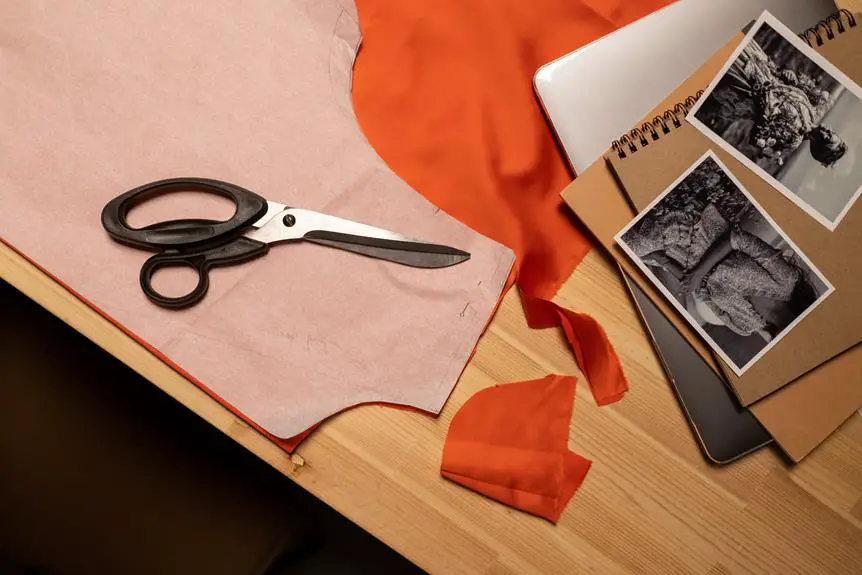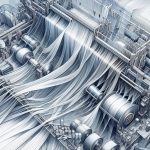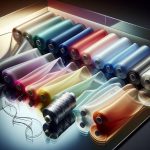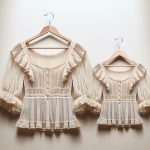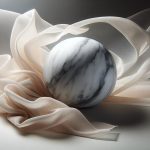When it comes to choosing the best fabrics for powered scissors, it's like finding the perfect ingredients for a recipe—you want the right combination for a flawless outcome. Understanding the properties of different fabrics can elevate your cutting experience to new heights.
You'll want to consider factors like thickness, weave, and fiber content to ensure smooth and precise cutting. Whether it's delicate chiffon or sturdy denim, each fabric presents unique challenges and opportunities.
By mastering the art of selecting the best fabrics for powered scissors, you'll unlock a world of creative possibilities and achieve impeccable results in your sewing and crafting projects.
Let's dive into the realm of fabrics and discover the perfect matches for your powered scissors.
Key Takeaways
- Heavy denim and canvas provide the necessary strength and weight for durable items when using powered scissors.
- Synthetic fabrics like nylon and polyester offer durability, flexibility, and smooth cutting through various materials when using powered scissors.
- Natural fibers such as silk blend and cotton blend are ideal for delicate materials and offer a smooth and clean cut when using powered scissors.
- Specialized fabrics like Kevlar, Gore-Tex, or spandex blends offer unique characteristics for specific project requirements and are suitable for projects that require precision cutting with powered scissors.
Factors to Consider When Choosing Fabrics
Considering the durability, thickness, and flexibility of fabrics is essential when choosing the best materials for powered scissors. These factors play a crucial role in determining the effectiveness of the cutting process. Durability is key, as it ensures that the fabric can withstand the repetitive motion of the scissors without fraying or tearing. Additionally, the thickness of the fabric impacts the precision of the cut, as thicker fabrics may require more powerful scissors to achieve a clean edge. When it comes to flexibility, the ability of the fabric to move and adapt during cutting techniques is vital for achieving smooth and accurate results.
When selecting fabrics for powered scissors, it's important to consider the cutting techniques that will be utilized. For intricate or detailed cuts, a fabric with high durability and moderate thickness is preferable. This combination allows for precision cutting without compromising the integrity of the fabric. Understanding the interplay between these factors will enable you to choose the most suitable fabrics for your powered scissors, ultimately enhancing the quality and efficiency of your cutting projects.
Best Thin Fabrics for Precision Cutting
When using powered scissors, focus on selecting thin fabrics that provide optimal precision during cutting. Thin fabrics are essential for precision cutting as they allow for clean, accurate lines and intricate detailing. Two excellent options for precision cutting are silk blends and microfiber, especially when working with delicate materials. Silk blends offer a luxurious feel and a smooth, fine texture that makes them ideal for precise cutting, while microfiber is known for its softness and ability to mimic the texture of natural fibers, making it perfect for intricate designs.
To further illustrate the suitability of these fabrics for precision cutting, consider the following comparison table:
| Fabric | Description |
|---|---|
| Silk Blends | Luxurious feel, smooth texture |
| Microfiber | Soft, mimics natural fiber texture |
Both silk blends and microfiber are lightweight and delicate, allowing for effortless maneuvering of powered scissors to achieve precise cuts without fraying or snagging. Their thin and smooth textures make them the best choice for mastering the art of precision cutting.
Ideal Thick Fabrics for Powered Scissors
For thick fabrics, focus on selecting materials that offer durability and ease of cutting with powered scissors. Heavy denim and canvas are excellent choices for projects requiring sturdy and thick fabrics. These materials provide the necessary heft and strength for durable garments, bags, and other heavy-duty items. When using powered scissors on heavy denim or canvas, opt for a pair with a robust motor and sharp blades to effortlessly cut through the fabric.
Leather is another thick fabric that can be challenging to cut without the right tools. Powered scissors equipped with a strong motor and sharp blades are essential for cleanly cutting through leather. These scissors offer precision and control, ensuring that leather pieces maintain their shape and integrity.
Upholstery fabrics, often thick and dense, are commonly used for furniture, car interiors, and other heavy-duty applications. Powered scissors are invaluable for cutting through these dense fabrics efficiently. Look for scissors with a reliable motor and ergonomic design to tackle upholstery projects with ease.
When working with thick fabrics, powered scissors with the right features can make a substantial difference in the quality and efficiency of your projects.
Synthetic Fabrics That Work Well
When it comes to synthetic fabrics that work well with powered scissors, there are a few top choices:
- Nylon is a popular option due to its durability. It can withstand the force of powered scissors without fraying or breaking easily.
- Polyester is another great choice. It offers flexibility, allowing for smooth cutting through various materials. It is known for its resistance to wrinkles and abrasion, making it a reliable option for powered scissors.
- If you're looking for stretch, spandex is the way to go. It provides the give needed for intricate cuts and allows for easy manipulation of the fabric.
These three synthetic fabrics have distinct qualities that make them suitable for use with powered scissors. Whether you prioritize durability, flexibility, or stretch, nylon, polyester, and spandex offer reliable options for efficient and precise cutting.
Nylon for Durability
Achieve durability by choosing nylon, a synthetic fabric that works well with powered scissors. Nylon is known for its exceptional strength and fabric longevity, making it an ideal choice for projects that require resilience and endurance. When using powered scissors, consider the following benefits of nylon:
- Abrasion Resistance: Nylon fabric is highly resistant to abrasion, ensuring that it can withstand the repetitive cutting motions of powered scissors without deteriorating quickly.
- Tear Strength: Nylon exhibits remarkable tear strength, allowing it to endure the stress and tension caused by the cutting action of powered scissors.
- Chemical Resistance: Nylon is resistant to many chemicals, making it suitable for use in various industries where powered scissors are employed for cutting different materials.
Selecting nylon fabric for your powered scissors applications can significantly enhance the durability and performance of your cutting tools.
Polyester for Flexibility
How can polyester enhance the flexibility of your powered scissors?
Polyester is a synthetic fabric known for its exceptional flexibility and durability, making it an excellent choice for powered scissors. When used as a component in the construction of scissor blades, polyester adds a level of suppleness that allows for smooth and precise cutting motions.
Unlike other fabrics, polyester doesn't easily lose its shape, ensuring that the scissors maintain their flexibility over time. Additionally, when combined with silk, polyester can create a blend that offers both flexibility and smoothness, further enhancing the cutting experience.
This combination of polyester and silk provides a balanced and controlled cutting action, making it easier to navigate through different types of fabrics with ease. For those seeking mastery in fabric cutting, polyester is a reliable choice for enhancing the flexibility of powered scissors.
Spandex for Stretch
Spandex offers exceptional elasticity and resilience, making it an optimal choice for enhancing the stretch and flexibility of powered scissors. It provides superior stretch when compared to cotton, making it ideal for applications requiring extensive movement. Additionally, spandex offers a high level of elasticity, allowing powered scissors to maneuver through different fabrics with ease. While cotton is known for its breathability, spandex excels in elasticity, providing the necessary flexibility for powered scissors to handle various cutting tasks. When considering the trade-off between elasticity and breathability, spandex is the clear choice for maximizing the performance of powered scissors.
- Superior stretch compared to cotton
- High level of elasticity for maneuverability
- Optimal choice for flexibility and performance
Natural Fibers Suitable for Powered Scissors
When using powered scissors, you should prioritize natural fibers over synthetic ones for optimal cutting performance. Natural fibers such as silk blend and cotton blend are ideal for delicate materials due to their soft and breathable qualities. When cutting with powered scissors, natural fibers offer a smooth and clean cut, reducing the likelihood of fraying or damage to the fabric.
Silk blend fabrics, known for their luxurious feel and drape, are particularly well-suited for powered scissors as they require precision and care when cutting. Additionally, cotton blend fabrics, being versatile and durable, provide an excellent cutting experience with powered scissors, making them suitable for a wide range of projects.
Natural fibers also tend to be more forgiving on powered scissors, reducing wear and tear on the blades. By choosing natural fibers, you can ensure that your powered scissors perform optimally and that your fabric remains in pristine condition, allowing you to produce high-quality, professional results.
Specialized Fabrics for Unique Projects
To tackle unique projects with powered scissors, you need to consider specialized fabrics that cater to specific design requirements and cutting challenges. When working with intricate designs or unconventional materials, relying on fabrics like wool or denim can enhance the precision and adaptability of your powered scissors.
- Specialized Projects:
For projects that require specific fabric properties such as flame retardancy, water resistance, or stretch, consider specialized fabrics like Kevlar, Gore-Tex, or spandex blends. These fabrics offer unique characteristics that cater to the demands of specialized projects, ensuring that your powered scissors can handle them with ease.
- Fabric Selection:
When working on unique projects, fabric selection is crucial. Opt for fabrics like carbon fiber, leather, or neoprene, which require precise cutting techniques due to their unique textures and thicknesses. These fabrics demand a higher level of precision cutting, making them suitable for specialized projects that push the boundaries of traditional fabric cutting.
- Precision Cutting:
Specialized projects often call for intricate and precise cutting. Fabrics such as silk, lace, or velvet require delicate handling and precise cutting techniques to maintain their integrity. Powered scissors equipped with the ability to handle these challenges can ensure impeccable results for specialized projects.
Frequently Asked Questions
Can Powered Scissors Be Used on Delicate Fabrics Like Silk or Chiffon?
You should avoid using powered scissors on delicate fabrics like silk or chiffon. They can easily snag or tear these materials. Instead, opt for hand-cutting or seek out specialized fabric shears for precise and safe handling.
What Are the Best Fabrics for Cutting Intricate Designs With Powered Scissors?
When cutting intricate designs with powered scissors, fabric compatibility is key. Look for fabrics like cotton, polyester, and denim that offer precision handling. These materials allow for smooth cutting techniques and intricate designs.
Are There Any Natural Fibers That Should Be Avoided When Using Powered Scissors?
When using powered scissors, avoid natural fibers like cotton and linen as they can jam the blades. Instead, opt for synthetic alternatives such as polyester or nylon to prevent potential damage and ensure smooth cutting.
Can Powered Scissors Handle Thick, Multi-Layered Fabrics Like Denim or Leather?
Yes, powered scissors can easily handle thick, multi-layered fabrics like denim and leather. They are designed to effortlessly cut through tough materials, making them a great tool for working with heavy fabrics.
Are There Any Specific Synthetic Fabrics That Are Known to Cause Issues With Powered Scissors?
When using powered scissors, be cautious with synthetic fabrics. They have the potential to cause damage due to their composition. Always check the compatibility of the fabric with your powered scissors to avoid any issues.
- Can You Get Organza Wet? - April 23, 2024
- Why Is Organza so Popular? - April 23, 2024
- What Do You Wear With Organza? - April 23, 2024

